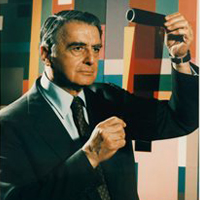Get Involved
Edwin H. Land Medal
The medal was established in 1992 with the Society for Imaging Science and Technology (IS&T) to recognize Edwin Land for his unique career as scientist, technologist, industrialist, humanist and public servant.
Society Connection
Edwin Land served on the Board of Directors and was named an Honorary Member in 1972 for his preeminent service in the advancement of optics. He also received the Frederic Ives Medal / Jarus W. Quinn Prize.
Key Funders
Polaroid Foundation, Polaroid Retirees Association, Manfred Heiting, Theodore Voss, John J. McCann
About Edwin H. Land
 Land was born 7 May 1909 in Bridgeport, Connecticut. He attended the Norwich Free Academy in CT, a semi-private high school, and graduated in 1927. During his first year at Harvard University he studied chemistry, but decided to leave the university for New York City.
Land was born 7 May 1909 in Bridgeport, Connecticut. He attended the Norwich Free Academy in CT, a semi-private high school, and graduated in 1927. During his first year at Harvard University he studied chemistry, but decided to leave the university for New York City.
While in the city, he invented the first inexpensive filters capable of polarizing light. Creating the filters was challenging because he lacked a laboratory. To get around this he allegedly would sneak into a laboratory at Columbia University at night to use equipment. He also frequented the New York City public library searching the scientific literature for prior work on polarizing substances. His breakthrough came when he realized that instead of attempting to grow a large single crystal of a polarizing substance, he could manufacture a film with millions of micrometer-sized polarizing crystals that were coaxed into perfect alignment with each other.
After developing the polarizing film, Land returned to Harvard. However, he did not finish his studies. In 1932 he established the Land-Wheelwright Laboratories with his Harvard physics instructor to commercialize his polarizing technology. After a few early successes developing polarizing filters for sunglasses and photographic filters, Land obtained funding from a series of Wall Street investors for further expansion. The company was renamed the Polaroid Corporation in 1937. Land further developed and produced sheet polarizers under the Polaroid trademark.
Although the initial major application was for sunglasses and scientific work, it quickly found many additional applications including: color animation in the Wurlitzer 850 Peacock jukebox of 1942, glasses in full-color stereoscopic (3-D) movies, and to control brightness of light through a window. During World War II, Land worked on military tasks, which included developing dark-adaptation goggles, target finders, the first passively guided smart bombs, and a special stereoscopic viewing system called the Vectrograph which revealed camouflaged enemy positions in aerial photography.
In 1947 at the society's Winter Meeting, Land demonstrated an instant camera and associated film. Called the Land Camera, it was in commercial sale less than two years later. Polaroid originally manufactured 60 units of this first camera. Fifty-seven were put up for sale at Boston's Jordan Marsh department store before the 1948 Christmas holiday. Polaroid marketers incorrectly guessed that the camera and film would remain in stock long enough to manufacture a second run based on customer demand. All 57 cameras and all of the film were sold on the first day of demonstrations. That same year, Land became one of the society's first Traveling Lecturers.
In the 1950s, Land and his team helped design the optics of the revolutionary Lockheed U-2 spy plane. Also in this decade, Land first discovered a two-color system for projecting the entire spectrum of hues with only two colors of projecting light. Some of this work was later incorporated in his Retinex theory of color vision. In the early 1970s, Land attempted to explain the previously known phenomenon of color constancy with his Retinex theory. His popular demonstrations of color constancy raised much interest in the concept. He considered his leadership towards the development of integral instant color photography — the SX-70 film and camera —his crowning achievement.
Although Land held no formal degree, he received numerous honorary degrees including ones from Harvard, Yale and Columbia. He received the Presidential Medal of Freedom for his optics research, the Ives Medal, and the Cresson, Potts, and Vermilye Medals from the Franklin Institute. Land was inducted into the National Inventors Hall of Fame and received the National Medal of Technology. He held 535 US patents. He resigned as chairman of Polaroid in 1980. In his retirement years, he founded the Rowland Institute for Science. Land died on 1 March 1991.
